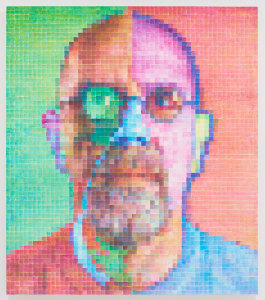ART-PRESENTATION: Chuck Close-Infinite
 A legendary portrait painter and master of photorealism, Chuck Close is one of the most influential artists of his generation, renowned for his meticulous detail and innovative technique of painting the human face, and is best known for his large-scale, photo-based portrait paintings, which has deeply impacted both American culture and the international art community.
A legendary portrait painter and master of photorealism, Chuck Close is one of the most influential artists of his generation, renowned for his meticulous detail and innovative technique of painting the human face, and is best known for his large-scale, photo-based portrait paintings, which has deeply impacted both American culture and the international art community.
By Efi Michalarou
Photo: Gary Tatintsian Gallery Archive

For the first time in Moscow, Chuck Close’s solo exhibition “Infinite”, feature oil paintings, mosaics, and tapestries, works that focus on the artist’s exploration of various media and stretch the boundaries of photographic means, methods, and approaches. In an artistic journey that has lasted more than 50 years, Close has revolutionized the art scene, transforming the canons of academic portrait and experimenting in different forms, from Polaroid photography to oil painting, mosaic-tilework, and tapestry. He has created portraits from tonal grids of fingerprints, pointillist dots, brushstrokes, paper pulp, and countless other media. One of the first artists to use the camera in the late 1970s to make photographs as both the basis for painted portraits and as works themselves, Close created his own iconic tool by putting a grid on the photograph and then transferring a proportional grid to the large-scale canvases. Close’s signature method can be considered as follows: a subject is photographed; the photographic image is transferred onto a large oil painting on canvas via a systematic, grid-based rubric. As the painting progresses, a series of colors are concentrically inserted into the cell, creating combinations that alter the way we perceive the overall color. “Optical blending” is the phenomenon by which the human eye merges neighboring colors into a single hue. The rigor and mathematical precision of the grid has prompted numerous critics to label Close’s process as “scientific.” The flip side of this is the unexpected musicality afforded by the grid. Its repetitions create a precise and regular rhythm, while the variations in color represent a series of literally chromatic modulations. In the age of the selfie, the art of portraiture, at first glance, seems to play the role of filtering the photographic reality. But for Close, the story goes much deeper: Art became a way to communicate his pain (both physical and emotional) as well as a tool to celebrate his victory against the circumstances that tried to stop him from living his dream. In addition to the partial paralysis that has made him use a wheelchair since 1988, the artist has prosopagnosia (face blindness), which drove him to portraits in the first place. He wanted to commit images of friends and family to memory, immortalizing the people and faces that mattered most. With his photographic memory for two-dimensional objects, he changes the faces to two-dimensional portraits. In fact, Close believes he has flourished as an artist not in spite of his neurological conditions, but because of them. The value and weight of the individual are portrayed in the artist’s works through hyperrealistic stylization. Creating a photo portrait can take Close several months—from developing the concept to approval of the final print—when one painting would take about 12 to 14 months. The result is the opposite of what most modern portraits do: There is no intent to flatter or embellish the person in the frame; any imperfection becomes part of the biography, revealing a person’s truth.
Photo: Chuck Close, Self-Portrait IV (Detail), 2014-2015, Oil on canvas, 243.8 × 213.4 cm, © Chuck Close, Courtesy of the Artist, Pace Gallery and Gary Tatintsian Gallery
Info: Gary Tatintsian Gallery, Serebryanicheskaya Naberezhnaya 19, Moscow, Russia, Duration: 18/6-25/9/2021, Days & Hours: Tue-Fri 12:00-20:00, Sat 12:00-18:00, https://tatintsian.com





